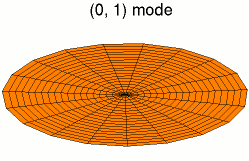Equation of Progressive Wave:
(This is a mathematical language for analysis of wave motion).
Suppose a progressive wave traveling from left to right along x - axis as shown in figure. Let us consider a particle vibrate with simple harmonically at the origin $o$.
The displacement '$y$' of the vibrating particle at origin '$O$', at any instant '$t$' is given by:
$y = a Sin \omega t$ (i)
Where, $a$ = amplitude of the particle; $\omega$ = angular velocity; $t$ = time
Again, Consider a particle '$P$' at distance '$x$' from the origin '$O$' as in figure. Let $\phi$ be the phase lag of the particle $P$. We know that for a distance of $\lambda$, Phase difference = $2\pi$.
So the Phase Difference '$\phi$' at '$P$' at a distance '$x$' from '$O$' is $(x/\lambda)2\pi$ Then the displacement of a particle '$P$' at distance '$x$' from '$O$' is,
$y = aSin(\omega t - \phi)$ (ii)
Substituting this value of '$(\phi)$' in $eq^n.$ (ii), we get
$y = a Sin(\omega t - \frac{2\pi x}{\lambda})$
The quantity $2\pi/\lambda = k$ is called wave number or propagation constant. Then
$y = aSin(\omega t - k x)$ (iii)
Since $\omega = 2\pi/T$; Then $eq^n$ (iii) becomes,
$y = a Sin(\frac{2\pi}{T} t - \frac{2\pi}{\lambda}x)$
or, $y = a Sin 2\pi(\frac{t}{T} - \frac{x}{\lambda})$ (iv)
Again, $\omega = 2\pi f = 2\pi v/\lambda$; Where '$v$' be the velocity of the wave, we have
$y = a Sin(\omega t - \frac{2\pi}{\lambda}x)$
or, $y = a Sin(\frac{2\pi v}{\lambda} t - \frac{2\pi}{\lambda}x)$
or, $y = a Sin \frac{2\pi}{\lambda} (vt - x)$ (v)
$Eq^n$ (iv) or $Eq^n$ (v) represents the Plane Progressive Wave. If the wave travels from right to left i.e. negative $x- axis$. So equation of the wave in this case is,
$y = a Sin \frac{2\pi}{\lambda} (vt + x)$ (vi)
Differential Equation of Wave Motion:
The equation of wave is (from $eq^n$ (v) )
$y = a Sin \frac{2\pi}{\lambda} (vt - x)$ (vii)
Differentiating $Eq^n$ (vii) with respect to $t$ is,
$\frac{\mathrm{d} y}{\mathrm{d} t} = \frac{2\pi v}{\lambda}a Cos (vt - x)$ (viii)
Again differentiating $eq^n$ (viii) with respect to $t$, we get
$\frac{\mathrm{d} ^2y}{\mathrm{d} t^2} = -\frac{4\pi^2 v^2}{\lambda^2}a Sin \frac{2\pi}{\lambda} (vt - x)$ (ix)
When the $eq^n$ (vii) is differentiated with repect to $x$, we get
$\frac{\mathrm{d} y}{\mathrm{d} x} = \frac{2\pi}{\lambda}a Cos \frac{2\pi}{\lambda}(vt - x)$
$\frac{\mathrm{d} ^2y}{\mathrm{d} x^2} = -\frac{4\pi^2}{\lambda^2}a Sin \frac{2\pi}{\lambda} (vt - x)$ (x)
From $Eq^n$ (ix) and (x), we have
$\frac{\mathrm{d} ^2y}{\mathrm{d} t^2} = v^2\frac{\mathrm{d} ^2y}{\mathrm{d} x^2}$ (xi)
Which is the differential wave equation.
Note: This is adapted from [Principle of PHYSICS - XII]
Click here for: Mathematical Expression of Stationary Wave
Return to Main Menu



